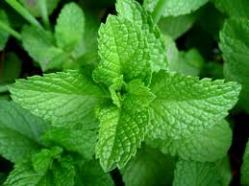(Picture taken from wikipedia)
Peppermint
Mentha x. piperita L.
Family Labiatae or Lamiaceae
Peppermint is a popular plant that is widely used for common colds, cough, respiratory problems, gastrointestinal issues, and digestive problems such as heartburn, nausea, vomiting, and morning sickness1. It belongs to the genus Mentha, whose native or naturalized species are found everywhere, except in the Antarctica. All species of this ubiquitous genus bear essential oils and have been used conventionally for thousands of years. Some of these oils have achieved high economic value, examples include cornmint M. arvensis (natural source of menthol), peppermint, Scotch peppermint M. gracilis, and Native spearmint M. spicata2.
Used by the Romans and Greeks as an aromatic and as an adornment with which to crown themselves during their feasts, the Athenians in particular thought mint would make their arms stronger if they would rub it on before battles3.
Ancient feasts included fragrant plants and flowers along with the exquisite meals, with the aromatics being considered even more important than the banquet itself. Ancient Greeks and Romans valued fragrance in three kinds during their parties: fresh flowers, perfumed unguent and incense. Mint leaves in particular were rubbed on the dining table while guests were given garlands made with fragrant flowers and leaves. The scent of mint was also used to refresh the spirit and ease stomach-aches4.
More than 3,000 names have been published in an attempt to classify Mentha species during the past 250 years, however hundreds of them are just synonyms (or illegitimate names) of previously identified species. Interestingly, only 18 species and 11 hybrids were identified during a very recent inclusive phylogenetic analysis, which included not only morphology but also chromosomal and essential oil analyses. Yet, research is still needed to achieve the complete typification of this polymorphic and complex genus2.
Mentha x piperita L., whose essential oil is widely used in clinical aromatherapy, is the hybrid resulted from the crossing of watermint M. aquatica and spearmint M. spicata. Although it is indigenous to Europe, it also is cultivated worldwide. Peppermint is valued in the food industry as well as in the pharmaceutical and cosmetic industries.
The average chemical composition of M. x piperita is menthol (up to about 51%), menthone (up to 32%), isomenthone (up to 10%), 1,8-cineole (up to 14%), menthyl acetate, menthofuran, limonene, pinenes, germacrene, and pulegone5.
Peppermint continues to be therapeutically used for gastrointestinal problems, tension headaches and respiratory issues. Although considered safe, some caution must be taken as adverse drug interactions have been reported5,6. Inhalation of peppermint essential oil has been shown to improve subject’s attention, memory, visuomotor speed, mood and energy7a. It also appears to enhance physical performance during exercise and to promote appetite, particularly in the elderly7a,b.
Tayarani-Najaran et al. reported that chemotherapy-induced emetic events can be significantly reduced in patients receiving internal doses of M. x piperita and M. spicata. Interestingly, when inhaled, M. x piperita appears to have no effect on gestational nausea and vomiting8, although the authors acknowledged weaknesses of study in terms of sample size and measure of nausea- and vomiting-provoking hormones. On the other hand, this might corroborate the reversible reduction in gastric acid secretion found in animal studies, and “the substantial spasmolytic effect of peppermint essential oil on the smooth muscles of the gastrointestinal tract” when ingested. Recent studies indicate this might be due to the interaction of peppermint’s menthol content with the calcium movement across cell membranes9,10. With proper size samples being considered as research continues to be carried, the efficacy of inhaled peppermint essential oil in reducing postoperative nausea and vomiting has been noted11. Peppermint is routinely used in chemotherapy units in the UK and in some US hospitals7a,b.
Other studies on peppermint include reports on the efficacy of inhalation of this oil in reducing the perceived level of mental fatigue or burnout12, radiation protection action of its leaf extract13, anti-tumor activity14 among others15.
Peppermint essential oil is another versatile, widely-studied, and very promissory oil. It is an energizing oil that can also be used for mood lifting, awareness, mental focus and concentration.
References:
- http://www.nlm.nih.gov/medlineplus/druginfo/natural/705.html
- Mint. The genus Mentha. Brian M. Lawrence (Ed.) CRC Press. 2007.
- The cultural history of plants. Sr. Ghillean Prance and Mark Nesbitt (Eds.) Routledge. 2005.
- Aroma. The cultural history of smell. Constance Classen, David Howes and Anthony Synnott. Routledge. 1994.
- Essential Chemistry for Aromatherapy. Sue Clarke. Churchill Livingstone; 2 edition, 2009.
- http://umm.edu/health/medical/altmed/herb/peppermint
- Antiemetic activity of volatile oil from Mentha spicata and Mentha × piperita in chemotherapy-induced nausea and vomiting. Z Tayarani-Najaran, E Talasaz-Firoozi, R Nasiri, N Jalali and MK Hassanzadeh.ecancer 2013, 7:290 DOI: 10.3332/ecancer.2013.290
- Study of the effect of Mint on nause and vomiting during pregnancy. Hajar Pasha, Fereshteh Behmanesh, Farideh Mohsenzadeh, Mahmood Hajahmadi, Ali Akbar Moghadamnia. Iranian Red Crescent Medical Journal. 2012. DOI: 10.5812/ircmj.3477
- Gastrointestinal clinical pharmacology of peppermint oil. H.-G. Grigoleit, P. Grigoleit. Phytomedicine. Volume 12, Issue 8 , Pages 607-611, 2 August 2005
- Pharmacology and preclinical pharmacokinetics of peppermint oil. H.-G. Grigoleit, P. Grigoleit. Phytomedicine. Volume 12, Issue 8 , Pages 612-616, 2 August 2005
- Review Article. Essential Oils for Complementary Treatment of Surgical Patients: State of the Art. Susanna Stea, Alina Beraudi, and Dalila De Pasquale. Evidence-Based Complementary and Alternative Medicine Volume 2014, Article ID 726341, 6 pages http://dx.doi.org/10.1155/2014/726341
- http://www.ncbi.nlm.nih.gov/pubmed/23140115
- http://www.ncbi.nlm.nih.gov/pubmed/16782650
- http://www.ncbi.nlm.nih.gov/pubmed/21452174
- http://search.nih.gov/search?utf8=✓&affiliate=nih&query=peppermint&commit.x=44&commit.y=11&commit=Search
7a. Shirley and Len Price’s Aromatherapy for Health Professionals. b. Jane Buckle’s Clinical Aromatherapy.

